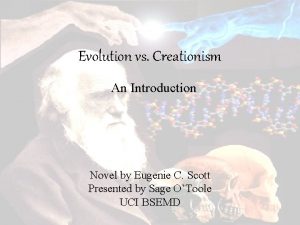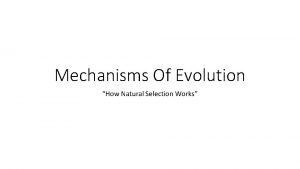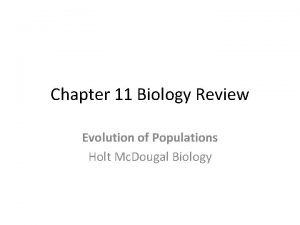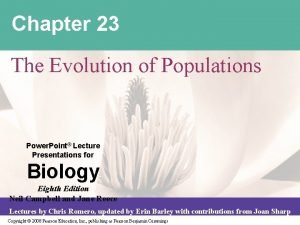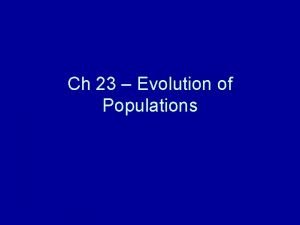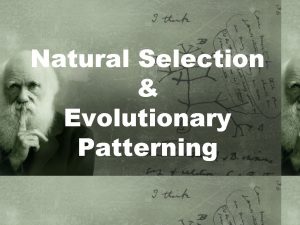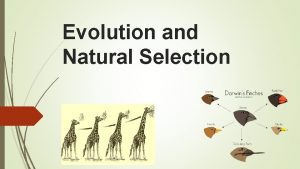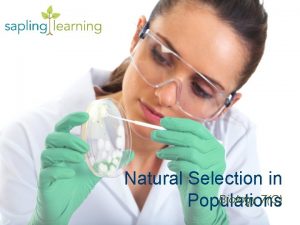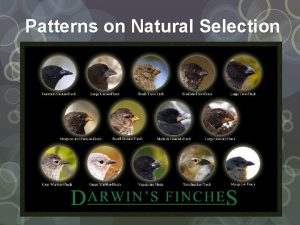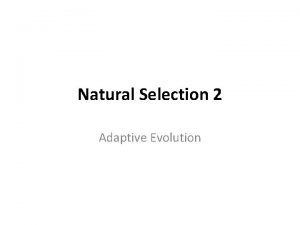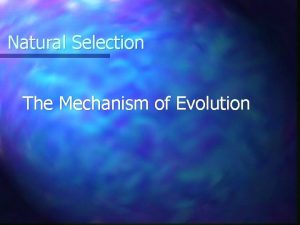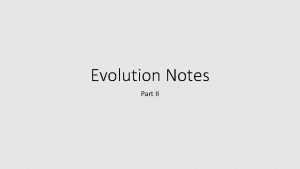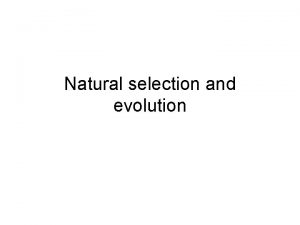Evolution of Populations Populations Recall that natural selection




















- Slides: 20

Evolution of Populations

Populations �Recall that natural selection affects populations, not individuals. �A population is defined as a group of organisms of the same species living together in a given area. �Individuals of a population can breed to create fertile offspring, transferring genes from one generation to the next.

Genes and Variation �All of the alleles for every gene present in a population at any one time are called the population’s gene pool. �Allele frequency—frequency with which a particular gene variant is found in a population

Changes to Gene Pools �New genes or alleles can be introduced into a gene pool through genetic mutations. �If the individual survives to pass on the gene to the next generation, the mutation becomes part of the gene pool. �Natural selection can also change gene pools. Ex. Introduction of a new predator

Genetic Equilibrium �Populations in a state of genetic equilibrium do not change or evolve. � Gene pools are stable. � Allele frequencies are stable. � No increase or decrease in the number of variations in the population. �Natural selection upsets genetic equilibrium and causes changes in populations.

Adaptive Radiation �Diversifying selection may lead to adaptive radiation �Adaptive Radiation—creation of new species from a species presented with new environmental conditions �Ex. Darwin’s finches in the Galapagos Islands

Speciation �Speciation—creation of new species �In order for a new species to evolve, populations must become reproductively isolated from one another.

Allopatric Speciation �Allopatric speciation—geographic isolation enables new species to be created �Ex. Construction of a dam creates two separate lakes

Geographic Isolation �Populations are separated by geographic barriers such as rivers or mountains that keep them apart.

Sympatric Speciation �Sympatric speciation—new species are created without geographic isolation �Ex. New species of fish evolve in the same lake �Behavioral and temporal isolation can lead to sympatric speciation.

Behavioral Isolation �Two populations are capable of interbreeding but have different behaviors that keep them apart. �Ex. Songs, courtship rituals

Temporal Isolation �Populations are kept apart because they reproduce in different months, time of day, etc. .

Gene Flow �Gene flow is the transfer of alleles from one population to another, often due to migration �Gene flow introduces new alleles into populations and increases variation. This fuels natural selection and evolution.

Genetic Drift �Genetic drift is the process by which changes in allele frequencies occur because of random events. �Small populations are affected the most.

Increasing Genetic Drift �Bottleneck Effect—a drastic change in environment such as a natural disaster significantly reduces population size. Survivors may have a very different gene pool than the starting population. �Founder Effect—random group of individuals is separated from the parent population. Again, the gene pool of the new population may be very different from the starting population

Patterns of Evolution �Convergent Evolution—unrelated organisms evolve similar adaptations usually due to similar environmental conditions

Patterns of Evolution �Divergent Evolution—related species become increasingly different from each other due to different environmental conditions

Patterns of Evolution �Coevolution—evolution of one species is a direct result of evolution of another species

Coevolution �Cooperative—both species benefit and generally evolve to depend on each other further and further �Ex. Hummingbird and flower �Antagonistic—species evolve counter-adaptations against each other �Ex. Snake and poisonous newt

Speed of Speciation �Punctuated Equilibrium —drastic changes create new species then little change occurs �Gradualism—species gradually change over time
 Natural selection vs evolution
Natural selection vs evolution Natural selection
Natural selection Types of natural selection in evolution
Types of natural selection in evolution Genetic drift vs gene flow vs natural selection
Genetic drift vs gene flow vs natural selection Difference between continuous and discontinuous variation
Difference between continuous and discontinuous variation Disruptive selextion
Disruptive selextion Artificial selection vs natural selection
Artificial selection vs natural selection Natural selection vs artificial selection
Natural selection vs artificial selection Natural selection vs artificial selection
Natural selection vs artificial selection Evolution of populations section 16-1 genes and variation
Evolution of populations section 16-1 genes and variation Chapter 16 evolution of populations vocabulary review
Chapter 16 evolution of populations vocabulary review Evolution of populations section 11 review
Evolution of populations section 11 review Section 16-1 genes and variation
Section 16-1 genes and variation Chapter 17 evolution of populations answer key
Chapter 17 evolution of populations answer key Chapter 23 the evolution of populations
Chapter 23 the evolution of populations Chapter 23: the evolution of populations
Chapter 23: the evolution of populations Smallest unit of evolution
Smallest unit of evolution Evolution of populations section 16-1 genes and variation
Evolution of populations section 16-1 genes and variation Thơ thất ngôn tứ tuyệt đường luật
Thơ thất ngôn tứ tuyệt đường luật Tôn thất thuyết là ai
Tôn thất thuyết là ai Phân độ lown ngoại tâm thu
Phân độ lown ngoại tâm thu
